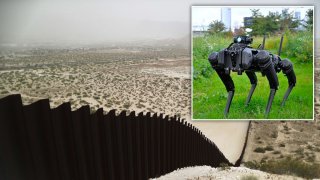
This story was originally reported by NBC 7's sister station, Telemundo 20. To read the article in Spanish, click here.
The U.S. government continues to strengthen border security to prevent the illegal crossing of immigrants into the country, which has been on the rise year after year, as well as to reduce the presence of human smugglers, drug smugglers and violence.
In the near future, migrants could face a new obstacle: robot dogs.
It is a quadrupedal 100-pound robot dog that can traverse all types of terrain such as sand, rocks and mountains, as well as human-built environments such as stairs.
"That's why you want legs and not tracks," said Gavin Kenneally, chief product officer at Ghost Robotics.
The new strategy is still in the testing phase and seeks to have the robots provide support to Border Patrol agents in the most inhospitable terrains, where they face the most dangerous threats, said the U.S Customs and Border Protection (CBP).
The Department of Homeland Security's (DHS) Science and Technology Directorate (S&T) unveiled the new technology on Tuesday, Feb. 1. The agency explained that, in this case, "man's best friend comes with a very futuristic twist."
U.S. & World
"The southern border can be an inhospitable place for man and beast, and that's exactly why a machine may excel there," Brenda Long, S&T program manager, said in a statement.
The goal of the program is to reduce the time human agents are exposed to life-threatening risks, S&T said.
This 100-pound robot was created in collaboration with Philadelphia-based Ghost Robotics and a company that already distributes robots around the world to assist with military and police missions.
According to agent Brett Becker of the CBP Innovation Team (INVNT), along the border agents are confronted by smugglers of people, drugs, firearms or weapons of mass destruction.
Robot dogs have been designed with different capabilities using U.S. Army technology and would have to prove that they can adapt to various missions. For example, different types of cameras can be added — thermal, zoom night vision, and chemical, biological, radiological and nuclear sensors — just to list a few, S&T reported.
After two and a half years of design, testing and development, robot dogs could soon accompany CBP personnel at the border.
MIGRANTS REACT TO NEW BORDER PATROL AGENT
Migrants in Tijuana who have had the experience of crossing the fences and desert areas between Mexico and the U.S. reacted to seeing the new dogs that the U.S. government will use to try to stop illegal migration to the country.
Some were afraid and others were surprised to see the long robotic legs of metal dogs, the cameras and the lack of a face.
"I think if I throw rocks at it, they are capable of throwing more people at us, I don't know, I don't know what to react," said Armando Andrade, a Michoacan migrant, adding that when crossing the border, you don't want to run into anything.
Other migrants who have already crossed the wall illegally and are seeking to hide their identity for fear of reprisals told Telemundo 20 they would have liked to meet them.
"If I had found him, I would have taken a picture with it, because it’s beautiful," a migrant from El Salvador told TELEMUNDO 20.
Migrants still seeking to reach the United States added that after seeing these images, they have one more obstacle in their dream of crossing the border, not only border patrol agents but also their technology.
NEW TECHNOLOGY LACKS HUMANITY ACTIVISTS SAY
Pro-immigrant activists opined on this new technology that for them it lacks humanity.
"Still a border agent, a human being, a person has some sort of sensitivity to migrants, but a robot, it would be very catastrophic if an accident happened," said José María García, activist and director of the Juventud 2000 shelter in Tijuana.
The dogs would also run into people fleeing violence in their country and facing moments of great despair in their attempt at a better life.
"What they're going to be able to do, we don't really know how that robot is going to operate," Garcia said.
Activists in Tijuana added that they would like the U.S. government to use technology to solve the underlying problems that today generate forced migration to their country and a system that does not generate so much pain and uncertainty in the migrant community.



